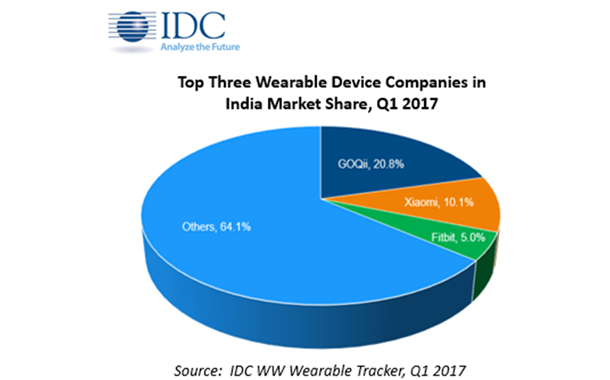Over Three-Fourth of Wearables Shipped in India are Below US$50- CY Q1 2017
According to the latest IDC Worldwide Quarterly Wearable Tracker, CY Q1 2017 saw total shipments of 612K units of wearables in India, which includes smart wearables, that can run third-party apps, and basic wearables which cannot run third-party apps.
In terms of product category, basic wearables accounted for almost 90 percent of total wearable shipments in Q1 2017. Celso Gomes, Associate Market Analyst, Client Devices, IDC India says “In addition to the low entry price of basic wearables, consumers are now getting better value from these devices as the category now offers advanced features. Features such as heart rate, sleep monitor and among others are soon becoming the must-have features in basic wearables, even in entry level (US$50) segments.”
Less than US$50 segment continues to dominate the category accounting for 78.6 percent of total wearable shipments in CY Q1 2017. This entry level segment is led by GoQii followed by Xiaomi. “New entrants like Titan, with aggressive marketing, have entered Indian wearable market in March further increasing the competition in this highly cluttered entry-level segment,” adds Gomes.
The offline share of wearables shipments stood at 36.2 percent in Q1 2017 up from 24.3 percent over the same period last year. The offline share has improved over the last couple of quarters and is expected to grow even further. Key new entrants like Fossil, Titan, etctera have entered the Indian wearable market primarily through retail stores. In addition, certain online vendors like Xiaomi and GoQii are also exploring offline channels to expand their customer base and enhance their presence.
Vendor Highlights:
GOQii: maintains its leadership in the Indian wearable market with 20.8 percent share. GOQii shipments increased 21.0 percent sequentially in CY Q1 2017 driven by fresh demand for its newly launched GoQii HR and promotional upgrade offer. It is gradually migrating from online only to hybrid channel to increase its offline presence.
Xiaomi: slipped to the second position with 10.1 percent vendor share as shipments declined 30.6 percent in Q1 2017 over the previous quarter. Increasing competition and limited supply of Mi Band 2 in Q1 2017 led to the decline of Xiaomi’s share in Indian wearables market.
Fitbit: maintained its third place in CY Q1 2017 even though shipments declined 42.7 percent sequentially. Newly launched Alta HR helped offsetting volume of earlier Alta shipments. New lineup of product launches in the coming quarter to prepare for the festive season are expected to revive the vendor’s shipments.
IDC India Forecast:
Wearable market is expected to grow at a double-digit in CY Q2 2017. To further intensify competition, few new vendors primarily China-based are expected to make inroads into Indian wearable market especially in sub US$50 segments. “Currently, primary use-case of wearables are focused on the specific niche market like fitness and health. Hence, to sustain volume and existence in long run, wearables should evolve to appeal to a wider consumer segment resulting in either to be a mainstream device or an essential product of a broader ecosystem.” says Navkendar Singh, Senior Research Manager, IDC India. Singh adds “Like IoT vendors, the wearables market should differentiate themselves either in terms of service offered with the product or its product features to enhance the scope of the market”


